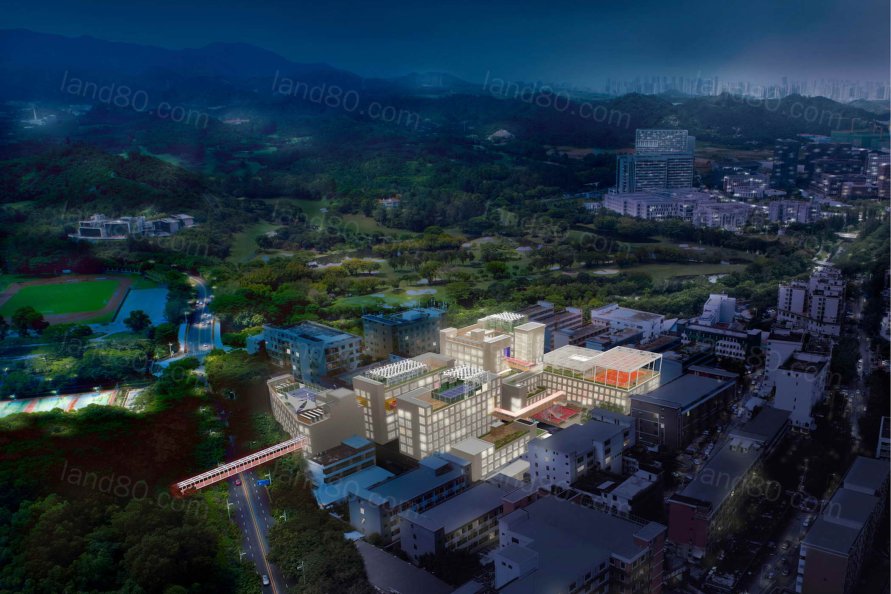Efficiency Lab for Architecture PLLC是一家由建筑师、规划师、设计师和教育工作者组成的事务所,致力于更好地理解建筑环境的效率。该项目标志着效率实验室和爱文之间的第五次合作。爱文是一个致力于为全球学生提供变革性的、以世界为中心的学习体验的组织。塘朗工业区是深圳南山区仅存的几个未被开发的"城中村"之一。与之前的拆迁和重建战略不同,政府已经将重点转移到对现有结构进行改造再利用的项目上。该地区现在被规划为教育和研究区,效率实验室是一个城市园区的总体规划、建筑设计、室内设计和装修的核心,该园区由七个现有的工业建筑组成,通过城市公共街道上的桥梁连接。除了通过一系列高架人行道连接这些建筑外,园区建筑的每个屋顶都将进行景观设计,包括操场、户外学习空间和花园。
Efficiency Lab for Architecture PLLC, a firm comprising a team of architects, planners, designers, and educators committed to a better understanding of efficiency in the built environment, is proud to announce the completion of an Early Learning Center in Shenzhen, China, the first school building of an innovative Avenues Shenzhen Campus master plan. The project marks the 5th collaboration between Efficiency Lab and Avenues: The World School, an organization dedicated to providing transformative, world-focused learning experiences to students around the globe. Tanglang Industrial Zone is one of the few remaining underdeveloped “urban villages” of Nanshan District in Shenzhen. As opposed to a previous strategy of tearing down and building anew, the government has shifted its focus to projects that embrace the adaptive reuse of existing structures. The area is now slated for redevelopment as an education and research zone, and Efficiency Lab is at the heart of the master planning, architectural design, interior design, and furnishings of an urban campus comprised of seven existing industrial buildings to be connected by bridges above the city’s public streets. In addition to connecting the structures through a series of elevated walkways, each rooftop of the campus buildings will be landscaped and will include playgrounds, outdoor learning spaces, and gardens.


项目是基于对一个三层楼的仓库和停车场的改造再利用。设计师从空间的减法和加法的角度来处理这个项目,包括在现有建筑上做非常精确的切割,以创造更大的连接性。“连接”的概念构成了项目的核心,从桥梁和人行道形式的物理连接到从现有仓库结构中战略性地切割出的精心编排的中庭所实现的视觉连接。
Avenues Shenzhen Early Learning Center was based on the adaptive reuse of a three-story warehouse and parking lot. Efficiency Lab approached the project from the perspective of strategic subtraction and addition, which included making very precise cuts in the existing building to create greater connectivity. The concept of ‘connections’ forms the heart of the project, from physical connections in the form of bridges and pedestrian walkways to visual connections enabled by carefully choreographed atriums strategically carved from the existing warehouse structure.

连接项目空间第一个决策是在空间内外打造一座桥,穿过一系列现有的榕树,为进入该设施提供了另一条流线,形成在屋顶树屋穿梭的氛围。这座桥让学生沉浸在周围环境的美丽之中,有助于培养学生对大自然的亲近心理。
The first strategic addition that will connect the Early Learning Center to other buildings on the campus is a bridge that has been built to pass through a series of existing banyan trees, providing a unique and inspirational path for entering the facility. Vertical playgrounds descend from the connector bridge, forming a sort of rooftop treehouse environment that weaves among the root structure of the trees. The bridge immerses students in the beauty of the surrounding environment, helping to nurture feelings of empathy towards nature.






在项目内部,多层中庭是是由楼板切开而成,创造了一系列的开口,为所有三层楼提供对角线的视野。主中庭位于楼板的中央,为建筑注入自然光。连接的概念贯穿整个室内,彩色编码的学习舱、门槛和壁龛为儿童提供了部分隐蔽性和视觉连接的双重性。在主中庭周围创建的有趣的互动学习区中,玻璃墙提供了可写的表面,而"钥匙孔"吊舱则作为从一个区域到另一个区域的门槛。
Inside the Early Learning Center, multi-level atria were cut from floor slabs of the existing building, creating a series of openings arranged to provide diagonal views across all three floors. The main atrium is centered in the middle of the floor plate, infusing natural light into the building. The concept of connections continues throughout the interior, with color-coded learning pods, thresholds, and niches providing children with the duality of partial seclusion and visual connectivity. Glazed walls provide writable surfaces in a fun and interactive learning zone created around the main atrium, while ‘keyhole’ pods serve as gateways from one zone to another.







设计师说:"我们很自豪能够为深圳的孩子们提供一个融入城市结构的游戏性学习环境。"早期学习中心是适应性再利用的一个光辉典范,也是校园建成后更大发展的前奏。
“We’re proud to be providing the children of Shenzhen with a playful learning environment that is woven into the urban fabric of the city,” says Asci. “The Early Learning Center is a shining example of adaptive reuse, and a precursor for even greater things to come as the campus is completed.”

Project: Avenues Shenzhen Early Learning Center
Location: Shenzhen, Guangdong Province, China
ELC Program: Toddler – Kindergarten: classrooms, art classroom, science classrooms, dance classrooms, common spaces, support spaces, recreation areas, offices, multipurpose room, playgrounds
ELC Floor Area: 82,000 ft2
Campus Masterplan Floor Area: 300,000 ft2
Masterplan: Efficiency Lab for Architecture
Design Architect: Efficiency Lab for Architecture
Interior Design: Efficiency Lab for Architecture
Local Design Coordination: WAY Design
Local Design Institute: CCDI
Local Planning Institute: Shenzhen Urban Planning Institute
Structural Design: Skidmore, Owings, & Merrill
Landscape Design: Terrain
Lighting Design: Claude Engel
Acoustic: WSDG
Completion date: Fall 2019
|